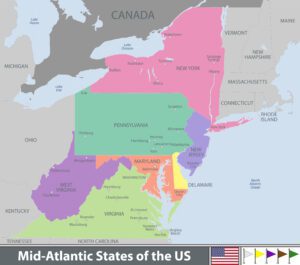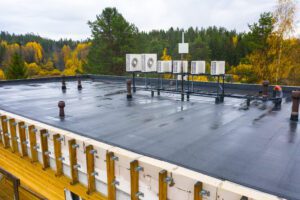The Mid-Atlantic climate, with its unique combination of extreme precipitation events, humid summers, and moderate winters, can pose significant challenges to commercial roofing. As a commercial property owner or manager, it’s crucial to understand the impact of this ever-changing climate on your roof’s performance and longevity.
In this article, we’ll explore the key climate features of the Mid-Atlantic region, how it affects commercial roofing, and the best type of roof for the region. This way, you can be sure your commercial roof can withstand the temperate climate of this region for years to come. Don’t let the weather take a toll on your investment. Schedule your roofing appointment today and ensure your building is protected from the elements.
The Mid-Atlantic Climate

The Mid-Atlantic region stretches from Virginia to New York State. It ranges from New Jersey and Delaware in the East to West Virginia and Virginia in the West. This region experiences four distinct seasons, with hot, humid summers and moderate but sometimes cold winters.
Because it’s bordered by the Atlantic Ocean in the East and much of the Appalachian Mountains in the West, it experiences a wide range of weather patterns. This area is also prone to Atlantic hurricanes, Nor’easters, and coastal influence due to its proximity to the Gulf Stream and Chesapeake Bay watershed. As a result, commercial roofs in the region must withstand extreme temperatures, heavy rainfall, and high winds.
Weather Patterns
The weather in the Mid-Atlantic region is influenced by various factors, including its coastal location and the Gulf Stream. This influence leads to a temperate climate characterized by a mix of subtropical and continental climatic patterns. The region is also known for its frequent foggy conditions, which can contribute to moisture-related issues on commercial roofs. Potential climate change could make the area warmer and wetter, so commercial building owners need to be aware of this possibility in the future.
Temperature Variations
Temperature fluctuations in the Mid-Atlantic region range from hot, humid summers to moderate, sometimes frigid winters. Summer temperatures can soar into the 90s (°F) or even higher, with high humidity levels adding to the discomfort. In parts of Eastern Maryland, humidity can reach almost 100% in the summer.
In contrast, winter temperatures can dip below freezing, especially in areas further inland. These temperature extremes can cause roofing materials to expand and contract, potentially leading to cracks, leaks, and other structural damage over time.
PrecipItation Trends
The Mid-Atlantic region receives significant amounts of precipitation throughout the year, with some areas experiencing over 40 inches of rainfall annually. The average rainfall across this region ranges from 32 to 52 inches. Rainfall variability is common, with heavy downpours often followed by periods of dry weather.
Additionally, the region is susceptible to Atlantic hurricanes and Nor’easters, which can bring torrential rain, strong winds, and snow. This combination of heavy rainfall and extreme weather events can strain commercial roofs immensely, making proper design, installation, and maintenance crucial for preventing water damage and protecting the building’s integrity.
How Does the Mid-Atlantic Climate Affect Commercial Roofing?
The Mid-Atlantic climate can cause a variety of issues for commercial roofs. Heavy rainfall and extreme precipitation events can lead to leaks, ponding water, and structural damage if your roof isn’t properly designed and maintained. Additionally, the region’s hot summers and frequent heatwaves can cause materials to warp or degrade over time. Meanwhile, frost and coastal foggy conditions may contribute to moisture-related problems.
That means you need a commercial roof that can withstand temperatures that sometimes range above 100°F and below 20°F. It also needs to handle the coastal influence of Atlantic hurricanes, including the heavy rainfall and strong winds it brings. Additionally, your commercial must be strong enough to take the impact of heavy snowfall due to Nor’easters. The four distinct seasons of this region mean your commercial roof needs to be ready for anything.
Which Roofing Type Is Best for My Business in the Mid-Atlantic?

Considering the unique challenges the Mid-Atlantic climate poses, selecting a roofing system that offers durability, energy efficiency, and weather resistance is essential. In the Mid-Atlantic region, that means primarily choosing from built-up roofing, modified bitumen roofing, thermoset roof membranes, thermoplastic, green, and metal roofs.
- Built-Up Roofing (BUR): BUR is an old industrial roofing type made of continuous, semi-flexible layers of felt or fabric plies, asphalt-based materials, and aggregates. These roofs are fire-resistant, durable, waterproof, and low-maintenance.
- Modified Bitumen (MB): MB is a layered industrial roofing material with a petroleum-based substance between the plies, giving it a rubberized appearance. It is durable, can handle foot traffic, and reflects sunlight for energy savings.
- Thermoplastic Membranes: Thermoplastic polyolefin (TPO) and polyvinyl chloride (PVC) roofing are thermoplastic membranes. TPO is a single-ply membrane system popular in commercial roofing. Made in sheets, it is durable, weather-resistant, and energy-efficient. PVC is a thermoplastic, single-ply membrane resistant to chemicals, grease, and fire. It comes in sheets and provides a waterproof seal around rooftop penetrations.
- Thermoset Membranes: Ethylene propylene diene monomer (EPDM) falls in the thermoset category. EPDM is a synthetic, rubber-like material that remains stable under temperature changes. It offers flexibility, UV resistance, and hail damage resistance. EPDM roofs can be black or light-colored for energy savings.
- Green Roofs: Green roofs incorporate living vegetation to improve air quality. They are expensive to build and require regular maintenance, including watering, weeding, and tending to plants.
- Metal Roofs: Metal roofs are environmentally friendly, made from recycled metals like steel and aluminum, and can be recycled at the end of their life. They are long-lasting and maintain their energy-saving properties over time.
Single-ply membranes, such as TPO and EPDM, are excellent choices for the region due to their ability to withstand temperature fluctuations, resist punctures and tears, and provide energy-efficient benefits. However, only a roofing professional can help you determine the best type of roof for your specific building. You must also consider the type of business you operate, as some roofs are better for certain industries. Our professional roofing assessment tools can help you identify the best solution for your specific needs and location.
Need a Consultation for Your Commercial Roof?
Understanding the Mid-Atlantic climate and its effects on commercial roofing is essential in ensuring the longevity and performance of your building’s roof. By selecting the appropriate roofing material and staying proactive with maintenance and repairs, you can protect your investment and avoid costly damages caused by weather-related issues. Don’t let the unpredictable Mid-Atlantic climate catch you off guard. Schedule a roofing estimate today and safeguard your commercial property against the elements.
Resources:


